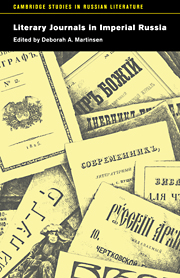1 - Introduction
Published online by Cambridge University Press: 11 March 2010
Summary
Of all the literary forms that the Russians borrowed from Western Europe in the eighteenth century, none has proven more durable than the journal.
What is a “journal?” The phenomenon it names has taken various forms in the last two hundred and fifty years, with such designators as “diary,” “revue,” “magazine,” “newspaper,” and “almanac.” Generically it is hard to place. A minimally satisfactory definition might run something like this: a periodical publication that lies somewhere between the newspaper, with its multiple authorship and focus on current events, and the book, which is usually a one-time event and the work of a single hand.
This much the Russian journal, in its various hypostases, has in common with its counterparts in other countries. But the ordinary literate Russian, on hearing the word zhurnal, no longer perceives it as foreign: it has been thoroughly assimilated. Most often it is associated with one kind of journal, the so-called “thick” or “fat” (tolstyi), which has dominated the nineteenth and twentieth centuries. This journal is cast on a grand scale, with a range of departments that speak to a variety of intellectual, cultural, and literary interests, and with a more or less discernible ideology. Its vital center, however, has always been belles-lettres, especially prose fiction and literary criticism. Indeed, it was largely in and through the thick journal that Russian literature found its public and worked its magic. Russia being what it is, this magic inescapably assumed extra-textual dimensions in the eyes of readers and critics.
- Type
- Chapter
- Information
- Literary Journals in Imperial Russia , pp. 1 - 8Publisher: Cambridge University PressPrint publication year: 1998



